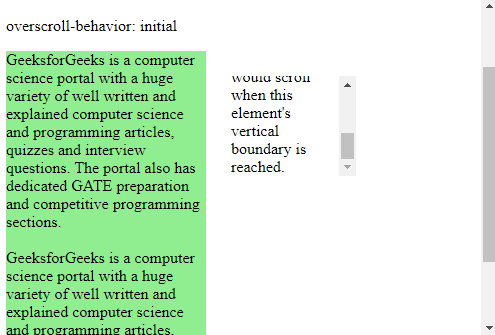CSS | overscroll-behavior Property
Last Updated : 21 Nov, 2019
Improve
The overscroll-behavior property is used to set the behavior of the browser when the boundary of a scrolling area is reached. This property can be used to prevent unwanted scrolling in pages where there are multiple scroll areas. It is a shorthand for the overscroll-behavior-x and overscroll-behavior-y properties. Syntax:
overscroll-behavior: auto | contain | none | initial | inheritProperty Values:
- auto: It is used to set the scrolling behavior to default. The whole page along with the element will scroll even if the boundary of the element is reached. It is the default value. Example:
html <!DOCTYPE html> <html> <head> <title> CSS | overscroll-behavior </title> <style> .container { display: flex; } .main-content { width: 200px; background-color: lightgreen; } .smaller-box { overscroll-behavior: auto; height: 100px; width: 125px; margin: 25px; overflow-y: scroll; } </style> </head> <body> <h1 style="color: green"> GeeksforGeeks </h1> <b>CSS | overscroll-behavior</b> <p>overscroll-behavior: auto</p> <div class="container"> <div class="main-content"> GeeksforGeeks is a computer science portal with a huge variety of well written and explained computer science and programming articles, quizzes and interview questions. The portal also has dedicated GATE preparation and competitive programming sections.<br><br> GeeksforGeeks is a computer science portal with a huge variety of well written and explained computer science and programming articles, quizzes and interview questions. The portal also has dedicated GATE preparation and competitive programming sections. </div> <div class="smaller-box"> This is a smaller element that is also scrollable. The overscroll behavior can be used to control if the main content behind would scroll when this element's vertical boundary is reached. </div> </div> </body> </html>

- contain: It is used to set the scrolling behavior to default only on the element used. Scrolling the element further after it has reached the boundary will not scroll the elements behind it. No scroll-chaining would occur in the neigring scrolling areas. Example:
html <!DOCTYPE html> <html> <head> <title> CSS | overscroll-behavior </title> <style> .container { display: flex; } .main-content { width: 200px; background-color: lightgreen; } .smaller-box { overscroll-behavior: contain; height: 100px; width: 125px; margin: 25px; overflow-y: scroll; } </style> </head> <body> <h1 style="color: green"> GeeksforGeeks </h1> <b>CSS | overscroll-behavior</b> <p>overscroll-behavior: contain</p> <div class="container"> <div class="main-content"> GeeksforGeeks is a computer science portal with a huge variety of well written and explained computer science and programming articles, quizzes and interview questions. The portal also has dedicated GATE preparation and competitive programming sections.<br><br> GeeksforGeeks is a computer science portal with a huge variety of well written and explained computer science and programming articles, quizzes and interview questions. The portal also has dedicated GATE preparation and competitive programming sections. </div> <div class="smaller-box"> This is a smaller element that is also scrollable. The overscroll behavior can be used to control if the main content behind would scroll when this element's vertical boundary is reached. </div> </div> </body> </html>

- none: It is used to prevent scroll-chaining on all elements. The default scroll overflow behavior is also prevented. Example:
html <!DOCTYPE html> <html> <head> <title> CSS | overscroll-behavior </title> <style> .container { display: flex; } .main-content { width: 200px; background-color: lightgreen; } .smaller-box { overscroll-behavior: none; height: 100px; width: 125px; margin: 25px; overflow-y: scroll; } </style> </head> <body> <h1 style="color: green"> GeeksforGeeks </h1> <b>CSS | overscroll-behavior</b> <p>overscroll-behavior: none</p> <div class="container"> <div class="main-content"> GeeksforGeeks is a computer science portal with a huge variety of well written and explained computer science and programming articles, quizzes and interview questions. The portal also has dedicated GATE preparation and competitive programming sections.<br><br> GeeksforGeeks is a computer science portal with a huge variety of well written and explained computer science and programming articles, quizzes and interview questions. The portal also has dedicated GATE preparation and competitive programming sections. </div> <div class="smaller-box"> This is a smaller element that is also scrollable. The overscroll behavior can be used to control if the main content behind would scroll when this element's vertical boundary is reached. </div> </div> </body> </html>

- initial: It is used to set the overscroll behavior to default value. Example:
html <!DOCTYPE html> <html> <head> <title> CSS | overscroll-behavior </title> <style> .container { display: flex; } .main-content { width: 200px; background-color: lightgreen; } .smaller-box { overscroll-behavior: initial; height: 100px; width: 125px; margin: 25px; overflow-y: scroll; } </style> </head> <body> <h1 style="color: green"> GeeksforGeeks </h1> <b>CSS | overscroll-behavior</b> <p>overscroll-behavior: initial</p> <div class="container"> <div class="main-content"> GeeksforGeeks is a computer science portal with a huge variety of well written and explained computer science and programming articles, quizzes and interview questions. The portal also has dedicated GATE preparation and competitive programming sections.<br><br> GeeksforGeeks is a computer science portal with a huge variety of well written and explained computer science and programming articles, quizzes and interview questions. The portal also has dedicated GATE preparation and competitive programming sections. </div> <div class="smaller-box"> This is a smaller element that is also scrollable. The overscroll behavior can be used to control if the main content behind would scroll when this element's vertical boundary is reached. </div> </div> </body> </html>

- inherit: It is used to set the scrolling behavior to inherit from the parent.
- Chrome 63.0
- Firefox 59.0
- Edge 18.0
- Opera 50.0